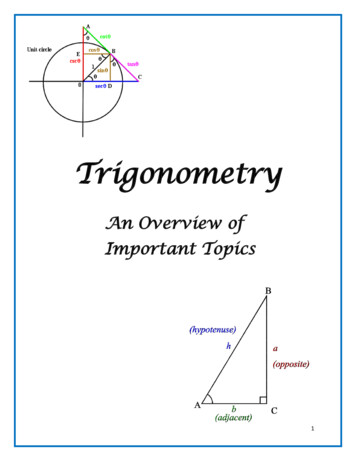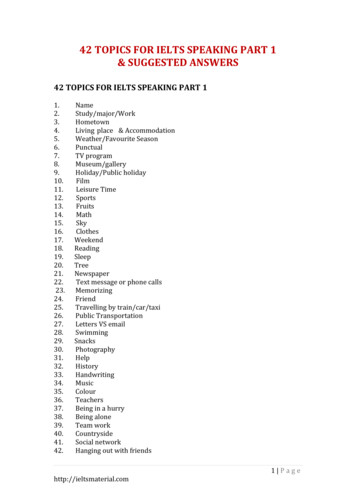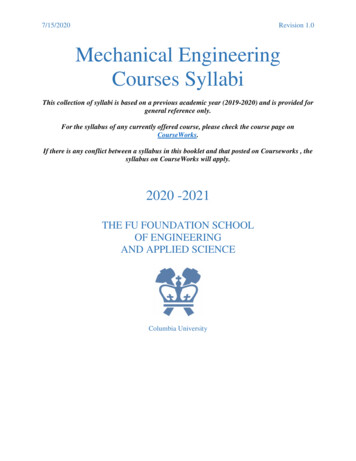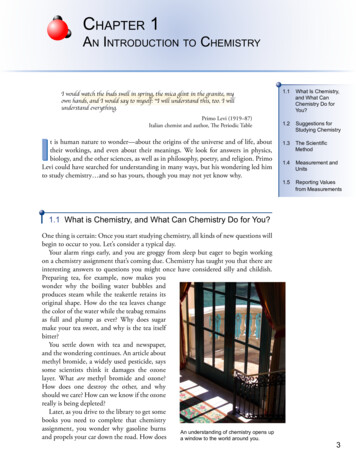
Transcription
TrigonometryAn Overview ofImportant Topics1
ContentsTrigonometry – An Overview of Important Topics . 4UNDERSTAND HOW ANGLES ARE MEASURED . 6Degrees . 7Radians . 7Unit Circle. 9Practice Problems . 10Solutions. 11TRIGONOMETRIC FUNCTIONS . 12Definitions of trig ratios and functions . 12Khan Academy video 2 . 14Find the value of trig functions given an angle measure . 15Find a missing side length given an angle measure . 19Khan Academy video 3 . 19Find an angle measure using trig functions . 20Practice Problems . 21Solutions. 24USING DEFINITIONS AND FUNDAMENTAL IDENTITIES OF TRIG FUNCTIONS . 26Fundamental Identities . 26Khan Academy video 4 . 28Sum and Difference Formulas. 29Khan Academy video 5 . 31Double and Half Angle Formulas . 32Khan Academy video 6 . 34Product to Sum Formulas . 35Sum to Product Formulas . 36Law of Sines and Cosines . 37Practice Problems . 39Solutions. 42UNDERSTAND KEY FEATURES OF GRAPHS OF TRIG FUNCTIONS . 43Graph of the sine function (𝒚 𝒔𝒊𝒏 𝒙) . 44Graph of the cosine function (𝒚 𝒄𝒐𝒔 𝒙) . 452
Key features of the sine and cosine function. 46Khan Academy video 7 . 51Graph of the tangent function (𝒚 𝒕𝒂𝒏 𝒙) . 52Key features of the tangent function . 53Khan Academy video 8 . 56Graphing Trigonometric Functions using Technology . 57Practice Problems . 60Solutions. 62Rev. 05.06.2016-43
Trigonometry – An Overview of Important TopicsSo I hear you’re going to take a Calculus course? Good idea to brush up on yourTrigonometry!!Trigonometry is a branch of mathematics that focuses on relationships betweenthe sides and angles of triangles. The word trigonometry comes from the Latinderivative of Greek words for triangle (trigonon) and measure (metron).Trigonometry (Trig) is an intricate piece of other branches of mathematics suchas, Geometry, Algebra, and Calculus.In this tutorial we will go over the following topics. Understand how angles are measuredo Degreeso Radianso Unit circleo Practice Solutions Use trig functions to find information about right triangleso Definition of trig ratios and functionso Find the value of trig functions given an angle measureo Find a missing side length given an angle measureo Find an angle measure using trig functionso Practice Solutions Use definitions and fundamental Identities of trig functionso Fundamental Identitieso Sum and Difference Formulaso Double and Half Angle Formulaso Product to Sum Formulaso Sum to Product Formulaso Law of Sines and Cosineso Practice Solutions4
Understand key features of graphs of trig functionso Graph of the sine functiono Graph of the cosine functiono Key features of the sine and cosine functiono Graph of the tangent functiono Key features of the tangent functiono Practice SolutionsBack to Table of Contents.5
UNDERSTAND HOW ANGLES ARE MEASUREDSince Trigonometry focuses on relationships of sides and angles of a triangle, let’sgo over how angles are measured Angles are formed by an initial side and a terminal side. An initial side is said tobe in standard position when it’s vertex is located at the origin and the ray goesalong the positive x axis.An angle is measured by the amount of rotation from the initial side to theterminal side. A positive angle is made by a rotation in the counterclockwisedirection and a negative angle is made by a rotation in the clockwise direction.Angles can be measured two ways:1. Degrees2. Radians6
DegreesA circle is comprised of 360 , which is called one revolutionDegrees are used primarily to describe the size of an angle.The real mathematician is the radian, since most computations are done inradians.Radians1 revolution measured in radians is 2π, where π is the constant approximately3.14.How can we convert between the two you ask?Easy, since 360 2π radians (1 revolution)Then, 180 π radiansSo that means that 1 𝜋180radians7
And180𝜋degrees 1 radianExample 1Convert 60 into radians𝜋60 (1 degree) 60 180𝜋180 60𝜋180𝜋 radian3Example 2Convert (-45 ) into radians-45 𝜋180 45𝜋180 𝜋radian4Example 3Convert3𝜋23𝜋2radian into degrees (1 radian)180𝜋 3𝜋2 180𝜋 540𝜋2𝜋 270 Example 4Convert 7𝜋3radian into degrees7𝜋 180 1260 420 3𝜋3Before we move on to the next section, let’s take a look at the Unit Circle.8
Unit CircleThe Unit Circle is a circle that is centered at the origin and always has a radius of1. The unit circle will be helpful to us later when we define the trigonometricratios. You may remember from Algebra 2 that the equation of the Unit Circle is𝑥² 𝑦² 1.Need more help? Click below for a Khan Academy videoKhan Academy video 19
Practice Problems10
SolutionsBack to Table of Contents.11
TRIGONOMETRIC FUNCTIONSDefinitions of trig ratios and functionsIn Trigonometry there are six trigonometric ratios that relate the angle measuresof a right triangle to the length of its sides. (Remember a right triangle contains a90 angle)A right triangle can be formed from an initial side x and a terminal side r, where ris the radius and hypotenuse of the right triangle. (see figure below) ThePythagorean Theorem tells us that x² y² r², therefore r 𝑥² 𝑦². 𝜃 (theta) isused to label a non-right angle. The six trigonometric functions can be used tofind the ratio of the side lengths. The six functions are sine (sin), cosine (cos),tangent (tan), cosecant (csc), secant (sec), and cotangent (cot). Below you will seethe ratios formed by these functions.𝑦𝑜𝑝𝑝𝑜𝑠𝑖𝑡𝑒 �𝑠𝑒𝑥𝑎𝑑𝑗𝑎𝑐𝑒𝑛𝑡 �𝑠𝑒𝑦𝑜𝑝𝑝𝑜𝑠𝑖𝑡𝑒 �� 𝑠𝑖𝑑𝑒sin 𝜃 , also referred to ascos 𝜃 , also referred to astan 𝜃 , also referred to asThese three functions have 3 reciprocal functions𝑟csc 𝜃 , which is the reciprocal of sin 𝜃𝑦12
𝑟sec 𝜃 ,which is the reciprocal of cos 𝜃𝑥𝑥cot 𝜃 , which is the reciprocal of tan 𝜃𝑦You may recall a little something called SOH-CAH-TOA to help your remember thefunctions!SOH Sine opposite/hypotenuse CAH Cosine adjacent/hypotenuse TOA Tangent opposite/adjacentExample: Find the values of the trigonometric ratios of angle 𝜃Before we can find the values of the six trig ratios, we need to find the length ofthe missing side. Any ideas? Good call, we can use r 𝑥² 𝑦² (from thePythagorean Theorem)r 5² 12² 25 144 169 13Now we can find the values of the six trig functionssin θ cos θ tan θ ��𝑡 1251213513csc θ sec θ cot θ ��𝑒 131213551213
Example 5a) Use the triangle below to find the six trig ratiosFirst use Pythagorean Theorem to find the hypotenusea² b² c², where a and b are legs of the right triangle and c is thehypotenuse𝑜8415sin 𝜃 ℎ 10 5csc 𝜃 sin 𝜃 46² 8² 𝑐²36 64 𝑐²100 𝑐²cos 𝜃 𝑎ℎ 610tan 𝜃 𝑜𝑎 35 8643sec 𝜃 1cos 𝜃 53cot 𝜃 1tan 𝜃 34 100 𝑐²10 𝑐Example 6Use the triangle below to find the six trig ratios1² 𝑏² ( 5 )²sin 𝜃 1 𝑏² 5𝑏² 4𝑏 2cos 𝜃 2 51 52 2 55csc 𝜃 52 55sec 𝜃 51tan 𝜃 1 2cot 𝜃 512Need more help? Click below for a Khan Academy VideoKhan Academy video 214
Find the value of trig functions given an angle measureSuppose you know the value of 𝜃 is 45 , how can this help you find the values ofthe six trigonometric functions?First way: You can familiarize yourself with the unit circle we talked about.An ordered pair along the unit circle (x, y) can also be known as (cos 𝜃, sin 𝜃),since the r value on the unit circle is always 1. So to find the trig function valuesfor 45 you can look on the unit circle and easily see that sin 45 22, cos 45 22With that information we can easily find the values of the reciprocal functionscsc 45 2 2 2 22 2 , sec 45 2We can also find the tangent and cotangent function values using the quotientidentities15
tan 45 sin 45 cos 45 22 22 1cot 45 1Example 7𝜋Find sec ( ) 41𝜋cos( 4 )1 22 2Example 8𝜋Find tan ( ) 612 32 33Example 9Find cot 240 12 3 2 33Using this method limits us to finding trig function values for angles that areaccessible on the unit circle, plus who wants to memorize it!!!Second Way: If you are given a problem that has an angle measure of 45 , 30 , or60 , you are in luck! These angle measures belong to special triangles.If you remember these special triangles you can easily find the ratios for all thetrig functions.Below are the two special right triangles and their side length ratios16
How do we use these special right triangles to find the trig ratios?If the θ you are given has one of these angle measures it’s easy!Example 10Example 11Example 12Find sin 30 Find cos 45 Find tan 60 sin 30 12cos 45 22tan 60 31 3Third way: This is not only the easiest way, but also this way you can find trigvalues for angle measures that are less common. You can use your TI Graphingcalculator.First make sure your TI Graphing calculator is set to degrees by pressing mode17
Next choose which trig function you needAfter you choose which function you need type in your angle measureExample 13Example 14Example 15cos 55 0.5736tan 0 0sin 30 0.518
Find a missing side length given an angle measureSuppose you are given an angle measure and a side length, can you find theremaining side lengths?Yes. You can use the trig functions to formulate an equation to find missing sidelengths of a right triangle.Example 16𝑜𝑥First we know that sin 𝜃 ℎ, therefore sin 30 5Next we solve for x, 5 sin 30 𝑥Use your TI calculator to compute 5 sin 30,And you find out 𝑥 2.5Let’s see another example,Example 17We are given information about the opposite and adjacentsides of the triangle, so we will use tantan 52 𝑥 16𝑥16tan 52𝑥 12.5Need more help? Click below for a Khan Academy videoKhan Academy video 319
Find an angle measure using trig functionsWait a minute, what happens if you have the trig ratio, but you are asked to findthe angles measure? Grab your TI Graphing calculator and notice that above thesin, cos, and tan buttons, there is 𝑠𝑖𝑛 1 , 𝑐𝑜𝑠 1 , 𝑡𝑎𝑛 1 . These are your inversetrigonometric functions, also known as arcsine, arccosine, and arctangent. If youuse these buttons in conjunction with your trig ratio, you will get the anglemeasure for 𝜃!Let’s see some examples of this.Example 188We know that tan 𝜃 6So to find the value of θ, press 2nd tan on your calculatorand then type in (8/6)8𝑡𝑎𝑛 1 ( ) 53.136𝜃 53.13 How about anotherExample 19We are given information about the adjacent side and thehypotenuse, so we will use the cosine functioncos 𝜃 121𝑐𝑜𝑠 1 ( ) 602𝜃 60 20
Practice Problems21
22
23
Solutions24
Back to Table of Contents.25
USING DEFINITIONS AND FUNDAMENTAL IDENTITIES OF TRIGFUNCTIONSFundamental IdentitiesReciprocal Identitiessin 𝜃 1/(csc 𝜃)csc 𝜃 1/(sin 𝜃)cos 𝜃 1/(sec 𝜃)sec 𝜃 1/(cos 𝜃)tan 𝜃 1/(cot 𝜃)cot 𝜃 1/(tan 𝜃)Quotient Identitiestan 𝜃 (sin 𝜃)/(cos 𝜃)cot 𝜃 (cos 𝜃)/(sin 𝜃)Pythagorean Identitiessin²𝜃 cos²𝜃 11 tan²𝜃 sec²𝜃1 cot²𝜃 csc²𝜃Negative Angle Identitiessin( 𝜃) sin 𝜃cos( 𝜃) cos 𝜃tan( 𝜃) tan 𝜃csc( 𝜃) csc 𝜃sec( 𝜃) sec 𝜃cot( 𝜃) cot 𝜃Complementary Angle TheoremIf two acute angles add up to be 90 , they are considered complimentary.The following are considered cofunctions:sine and cosinetangent and cotangentsecant and cosecantThe complementary angle theorem says that cofunctions of complimentaryangles are equal.26
sin 54 cos 36 Example 20)How can we use these identities to find exact values of trigonometric functions?Follow these examples to find out! Examples 21-2621) Find the exact value of the expressionsin² 30 cos² 30 Solution: Since sin² 𝜃 cos² 𝜃 1, therefore sin² 30 cos² 30 122) Find the exact value of the expressionsin 45 tan 45 cos 45 sin 45 Solution: Since () tan 45 , therefore tan 45 tan 45 0cos 45 23) tan 35 cos 35 csc 35 Solution:sin 35 cos 35 cos 35 1 1sin 35 124) tan 22 cot 68 Solution: tan 22 cot 68 , therefore cot 68 cot 68 0225) cot 𝜃 , find csc 𝜃, where 𝜃 is in quadrant II3Solution: Pick an identity that relates cotangent to cosecant, like thePythagorean identity 1 cot² 𝜃 csc² 𝜃.2 21 ( ) csc² θ341 csc² 𝜃9139 csc² 𝜃139 csc 𝜃 13 csc 𝜃3The positive square root is chosen because csc is positive in quadrant II27
26) Prove the following identity is truecot 𝜃 sin 𝜃 cos 𝜃 cos² 𝜃Solution:cos 𝜃sin 𝜃 sin 𝜃1 cos 𝜃1 cos² 𝜃Need more help? Click below for a Khan Academy videoKhan Academy video 428
Sum and Difference FormulasIn this section we will use formulas that involve the sum or difference of twoangles, call the sum and difference formulas.Sum and difference formulas for sines and cosinessin(𝛼 𝛽) sin 𝛼 cos 𝛽 cos 𝛼 sin 𝛽sin(𝛼 𝛽) sin 𝛼 cos 𝛽 cos 𝛼 sin 𝛽cos(𝛼 𝛽) cos 𝛼 cos 𝛽 sin 𝛼 sin 𝛽cos(𝛼 𝛽) cos 𝛼 cos 𝛽 sin 𝛼 sin 𝛽How do we use these formulas?Example 27 Find the exact value of cos 105 Well we can break 105 into 60 and 45 since those values are relatively easy tofind the cosine of.Therefore cos 105 cos(60 45 ) cos 60 cos 45 sin 60 sin 45 Using the unit circle we obtain,1 2 3 2 222 2 24 641 4 ( 2 6)Example 28 Find the exact value of sin 15 sin(45 30 ) sin 45 cos 30 cos 45 sin 30 2 3 22 64 24 2 1 2 2 14( 6 2)29
Sum and difference formulas for tangenttan 𝛼 tan 𝛽tan(𝛼 𝛽) 1 tan 𝛼 tan 𝛽tan 𝛼 tan 𝛽tan(𝛼 𝛽) 1 tan 𝛼 tan 𝛽Example 29 Find the exact value of tan 75 tan 75 tan(45 30 ) tan 45 tan 30 1 tan 45 tan 30 33 31 31 3 33 3(rationalize the denominator)3 3 3 3 12 6 3 2 363 3 3 37𝜋Example 30 Find tan ( )12tan 7𝜋3𝜋 4𝜋𝜋 𝜋 tan ( ) tan ( )1212 124 3𝜋4𝜋3𝜋𝜋1 tan tan43tan tan1 3 1 3 1 3 1 3 1 3 1 3 4 2 3 2 2 3Cofunction Identitiescos(90 𝜃) sin 𝜃sec(90 𝜃) csc 𝜃sin(90 𝜃) cos 𝜃csc(90 𝜃) sec 𝜃tan(90 𝜃) cot 𝜃cot(90 𝜃) tan 𝜃Example 31Find cos 30 cos 30 sin(90 30 ) sin 60 3230
Need more help? Click below for a Khan Academy videoKhan Academy video 531
Double and Half Angle FormulasBelow you will learn formulas that allow you to use the relationship between thesix trig functions for a particular angle and find the trig values of an angle that iseither half or double the original angle.Double Angle Formulascos 2𝜃 cos²𝜃 sin²𝜃 2cos²𝜃 1 1 2sin²𝜃sin 2𝜃 2 sin 𝜃 cos 𝜃tan 2𝜃 2 tan 𝜃1 tan² 𝜃Half Angle Formulas𝜃1 cos 𝜃22𝜃1 cos 𝜃22𝜃1 cos 𝜃21 cos 𝜃cos sin tan 𝜃sin 𝜃21 cos 𝜃tan 𝜃1 cos 𝜃2sin 𝜃tan Lets see these formulas in action!Example 32 Use the double angle formula to find the exact value of eachexpressionsin 120 sin 120 sin 2(60 ) 2 sin 60 cos 60 3232
Example 33tan 𝜃 512𝑎𝑛𝑑 𝜋 𝜃 3𝜋2, 𝐹𝑖𝑛𝑑 cos 2𝜃First we need to find what the cos 𝜃 is. We know that tan 𝜃 is opposite leg overadjacent leg, so we need to find the hypotenuse since cos is adjacent overhypotenuse. We can use 𝑟 12² 5² 13 to find the length of thehypotenuse. Now we know the cos 𝜃 12. Now use the double angle formula to13find cos 2𝜃.5 22550119cos 2𝜃 1 2sin² 𝜃 1 2 ( ) 1 2 ( ) 1 13169169 169We take the positive answer since 𝜃 is in the third quadrant making the ratio anegative over a negative.Now lets try using the half angle formulaExample 34cos 15 3 2 3301 cos 30 1 2cos 15 cos 2222Choose the positive rootExample 354𝜃52cos 𝜃 and 90 𝜃 180 . 𝐹𝑖𝑛𝑑 sinFirst we use the Pythagorean Theorem to find the third side42 𝑥 2 5233
𝑥2 9𝑥 3sin 𝜃 35491 ( )𝜃 5 5 9 3 10sin 2221010Since sin is positive in the third quadrant we take the positive answerNeed more help? Click below for a Khan Academy videoKhan Academy video 634
Product to Sum Formulas1cos 𝐴 cos 𝐵 [cos(𝐴 𝐵) cos(𝐴 𝐵)]21sin 𝐴 sin 𝐵 [cos(𝐴 𝐵) cos(𝐴 𝐵)]21sin 𝐴 cos 𝐵 [sin(𝐴 𝐵) sin(𝐴 𝐵)]21cos 𝐴 sin 𝐵 [sin(𝐴 𝐵) sin(𝐴 𝐵)]2Example 36 Use the product-to-sum formula to change sin 75 sin 15 to a sum11sin 75 sin 15 [cos(75 15 ) cos(75 15 )] [cos 60 cos 90 ]221 11 [ 0] 2 2435
Sum to Product Formulassin 𝐴 sin 𝐵 2 sin (𝐴 𝐵𝐴 𝐵) cos ()22sin 𝐴 sin 𝐵 2 cos (𝐴 𝐵𝐴 𝐵) sin ()22cos 𝐴 cos 𝐵 2 cos (𝐴 𝐵𝐴 𝐵) cos ()22cos 𝐴 cos 𝐵 2 sin (𝐴 𝐵𝐴 𝐵) sin ()22Example 37 Use the sum-to-product formula to change sin 70 sin 30 into aproductsin 70 sin 30 2 cos (70 30 70 30 ) sin () 2 cos 50 sin 20 2236
Law of Sines and CosinesThese laws help us to find missing information when dealing with obliquetriangles (triangles that are not right triangles)Law of Sinessin 𝐴 sin 𝐵 sin 𝐶 𝑎𝑏𝑐You can use the Law of Sines when the problem is referring to two sets of anglesand their opposite sides.Example 38 Find the length of AB. Round your answer to the nearest tenth.Since we are given information about an angle, the side opposite ofthat angle, another angle, and missing the side opposite of that angle,we can apply the Law of Sines.sin 92 sin 28 15𝐴𝐵Multiply both sides by the common denominator in order to eliminatethe fractions. We do this so that we can solve for the unknown. Thisgives us,sin 92 𝐴𝐵 sin 28 15Then we can divide by sin 92. When we do this we find 𝐴𝐵 7Law of Cosines𝑐² 𝑎² 𝑏² 2𝑎𝑏 cos 𝐶𝑏² 𝑎² 𝑐² 2𝑎𝑐 cos 𝐵𝑎² 𝑏² 𝑐² 2𝑏𝑐 cos 𝐴You can use the Law of Cosines when the problem is referring to all three sidesand only one angle.37
Example 39 Find the length of AB. Round to the nearest tenth.Since all three sides of the triangle are referred to and information about oneangle is given, we can use the Law of Cosines.Since AB is opposite of C, we will call it c and use the following formula,𝑐² 𝑎² 𝑏² 2𝑎𝑏 cos 𝑐𝑐² 13² 20² 2(13)(20) cos 93 𝑐 2 596𝑐 1438
Practice Problems39
40
41
SolutionsBack to Table of Contents.42
UNDERSTAND KEY FEATURES OF GRAPHS OF TRIG FUNCTIONSIn this section you will get a brief introduction to the graphs of the three main trigfunctions, sine, cosine, and tangent. This section will not go over how to actuallygraph these functions, but will go over how to identify key features of the graphsof each function.The graphs of sine and cosine are considered periodic functions, which basicallymeans their values repeat in regular intervals known as periods.A periodic function is a function f such that𝑓(𝑥) 𝑓(𝑥 𝑛𝑝)We talked about the fact that one revolution of the unit circle is 2π radians, whichmeans that the circumference of the unit circle is 2π. Therefore, the sine andcosine function have a period of 2π.43
Graph of the sine function (𝒚 𝒔𝒊𝒏 𝒙) If you notice, the range of the sine function is [-1, 1] and the domain is(- , ) Also notice that the x-intercepts are always in the form nπ. Where n is aninteger This is an odd function because it is symmetric with respect to the origin The period is 2π because the sine wave repeats every 2π units44
Graph of the cosine function (𝒚 𝒄𝒐𝒔 𝒙) If you notice, the range of the cosine function is [-1, 1] and the domain is(- , ) This is an even function because it is symmetric with respect to the y axistherefore for all cos( -x ) cos (x) The period is also 2π because the cosine wave repeats every 2π units45
Key features of the sine and cosine functionAmplitude measures how many units above and below the midline of the graphthe function goes. For example, the sine wave has an amplitude of 1 because itgoes one unit up and one unit down from the x-axis.Y a sin xAMPLITUDE:a is the amplitude. The graph of y a sin x and y a cos x, where a 0 will have arange of [- a , a ]Below is the graph of y sin x46
What happens if you change the amplitude to 2? Below is the graph of y 2 sin x.You see how the graph stretched up right? Now the range is [-2, 2] instead of [-1,1].What do you think would happen if you changed the amplitude to ½? Or 3?Check it out belowDoes this happen with cosine as well? Recall the graph of y cos x47
Now lets take a look at y 2 cos xWe can conclude that the amplitude vertically stretches or shrinks both the sineand cosine graphs. Notice that when the amplitude was changed the function stillrepeats every 2π units, therefore the amplitude does not affect the period of thefunction.PERIODAgain lets look at the graph of y sin xNotice how the graph changes when we change the function to y sin 2x48
Did you notice that the sine wave repeats every π units now instead of every 2πunits? This means the function is finishing its cycle twice as fast, which means itsperiod is half as long. If you consider the function y a sin bx, the b value affectsthe period of the function. It will horizontally stretch or squish the graph.Think about what the graph would look like if you changed it to y sin 0.5x.There is a general formula used to find the period (ω) of a sine or cosine function𝜔 2𝜋 𝑏 You will notice that the sine and cosine functions are affected the same bychanges made in the equations, so changing the b value will have the same effecton the cosine function.Just to show you, below are the graphs of y cos x and y cos 3x49
PHASE SHIFTNot only can the graphs be contracted or stretched vertically and horizontally, butthey can also be shifted left and right and up and down. First we will focus onshifting the graph left and right.Since the sine function has been getting all the action, lets look at the cosinefunction y cos x𝜋If we change the equation to y cos(𝑥 ), watch what happens to the graph.2𝜋The blue wave is the original y cos x and the green wave is the y cos (𝑥 ).2𝜋You will notice that the graph was shifted units to the right. If the equation had2𝜋𝜋been y cos (𝑥 ), the graph would have shifted units to the left. When the22graph is shifted to the left or right it is called a “phase shift”. If you consider theequation y a cos (bx – c), the phase shift can be found by taking c/b. Again thesine function is affected the same.50
VERTICAL SHIFTThe last way we can alter the sine and cosine functions is by making a verticalshift. Lets take a look at what happens to the function when we change it toy cos x 3 (Notice the 3 is not in parenthesis)The blue wave is the original y cos x and the green wave is the functiony cos x 3. When you add a number at the end you shift the graph up thatmany units and if you subtract a number at the end you shift the graph down thatmany units. When the function is written in the form y a cos (bx – c) d, dcontrols whether the function will be shifted up or down.Need more help? Click below for a Khan Academy videoKhan Academy video 751
Graph of the tangent function (𝒚 𝒕𝒂𝒏 𝒙) If you notice, the range of the tangent function is ( , ) and the domain𝜋is {𝑥 𝑥 𝑛𝜋 , 𝑤ℎ𝑒𝑟𝑒 𝑛 𝑖𝑠 𝑎𝑛𝑦 𝑖𝑛𝑡𝑒𝑔𝑒𝑟}2 The x intercepts are always in the form of 𝑛𝜋The period is 𝜋The tangent will be zero wherever the numerator (sine) is zeroThe tangent will be undefined wherever the denominator (cosine) is zeroThe graph of the tangent function has vertical asymptotes at values of 𝑥 inthe form of 𝑥 𝑛𝜋 𝜋2 Since the graph is symmetrical about the origin, the function is an oddfunction52
Key features of the tangent functionAMPLITUDEAmplitude does not apply to the tangent function since there aren’t any minimumor maximum values.PERIODConsider the tangent function in the form 𝑦 𝑎 tan 𝑏𝑥. To determine the period𝜋use . Below is the graph of 𝑦 tan 𝑥, notice that the tangent function repeats𝑏every π units.Now look if we graph the function 𝑦 tan 2𝑥𝜋Notice now that the function repeats every units.253
VERTICAL ASYMPTOTESThe tangent function has something called vertical asymptotes, which areinvisible vertical lines that the function approaches, but never crosses. To find thetwo consecutive vertical asymptotes of a tangent function you can solve the twoequations 𝑏𝑥 𝜋2and 𝑏𝑥 𝜋2Consider the graph of the function 𝑦 tan 0.5𝑥You can see from the graph that there are vertical asymptotes at 𝜋 and 𝜋. Youcould have also used the equations to obtain this information.0.5𝑥 𝜋0.5 𝜋 and 0.5𝑥 𝜋0.5 𝜋54
PHASE SHIFTThe phase shift for the tangent works the same way as the sine and cosine𝜋function. Consider the graph of the function 𝑦 tan (𝑥 )2𝜋The blue is the function 𝑦 tan 𝑥 and the green is the function 𝑦 tan (𝑥 ).2𝜋𝜋Notice that the functions appear the same except 𝑦 tan (𝑥 ) is shifted22units to the right.VERTICAL SHIFTAgain this works the same for tangent as it did for sine and cosine. Consider thegraph of the function 𝑦 tan 𝑥 155
Again the function graphed in blue is the function 𝑦 tan 𝑥 and the functiongraphed in green is 𝑦 tan 𝑥 1. As you can see the only difference betweenthe two graphed functions is that the function 𝑦 tan 𝑥 1 is shifted up oneunit.Need more help? Click below for a Khan Academy videoKhan Academy video 856
Graphing Trigonometric Functions using TechnologyGraphing a function in your TI-Graphing Calculator is easy!First type your function into y1Next you need to change the mode on your calculator to radians. To do this firstpress MODE and then scroll down and select Radians.57
Then press ZOOM and choose option 7 ZTRIGOnce you choose option 7, your function should start to graph!58
Desmos is another way to use technology to graph Trig functionsGo to https://www.desmos.com/Click Start GraphingIn the upper right corner select the tools and type pi in for the stepNow you are ready to type in your function!59
Practice Problems60
61
SolutionsBack to Table of Contents.62
Unit Circle The Unit Circle is a circle that is centered at the origin and always has a radius of 1. The unit circle will be helpful to us later when we define the trigonometric ratios. You may remember from Algebra 2 that the equation of the Unit Circle is T² U² 1. Need more help?











